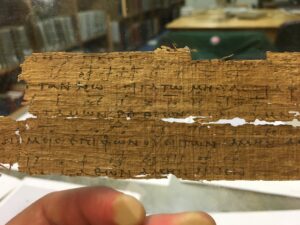
NASHVILLE (BP) – When SBC President Bart Barber calls the 2023 annual meeting to order, he will do so with the Bunyan Gavel, made from an oak piling in the foundation of the prison where John Bunyan wrote Pilgrim’s Progress.
For Barber, the Bunyan Gavel (one of 12 historic gavels to choose from) represents not only an incredibly important figure in Church history, but also a personal connection from his early ministry.
“Last year at the annual meeting in Anaheim we used a lot of different gavels … and the one that really caught my attention was the Bunyan Gavel,” Barber told Baptist Press.
The gavel was originally presented to R.G. Lee in 1949 by M. Theron Rankin of Virginia. Lee was president of the convention in 1949 when the Convention met in Oklahoma City, making him the first president to use the gavel while presiding over a convention.
“It’s a gavel that connects us to our roots, even beyond Southern Baptist life to the place from which our Southern Baptist ideas came from when they were just in ‘germ form.’ He was at the vanguard and the forefront of the ideas that matured and came down to who were as Southern Baptists. And also I had some personal connection to Bunyan that made this an appealing choice for me. It’s an emotional connection in a lot of ways. The moment that I knew it existed, I was in love with it.”
Barber’s connection to Bunyan began with his first doctoral seminar back in 2000 at Southwestern Baptist Theological Seminary.
The class was a look at Baptist theologians, and for his topic in the seminar, Barber chose John Bunyan’s view of the priesthood of all believers.
It so happened that this subject was first chronologically in the class, meaning Barber would be the first student to present in front of the class in a matter of weeks.
“I don’t know that I can describe how terrifying that was,” Barber said. “I’d never read a Ph.D. seminar paper. I had certainly never written a Ph.D. seminar paper. I’d never seen anybody else present a Ph.D. paper, and suddenly I’m having to put one together, and I’ve got two weeks to get it done.”
Over the next several days Barber said he “immersed himself” into all of the writing of Bunyan.
“I just fell in love with John Bunyan during that 10 days of total immersion,” Barber said.
“It became very important to me. It sort of launched the trajectory of my doctoral work. I came to realize that this was a guy of such courage and determination who spent 12 years in prison when he could have walked out any day he wanted to. Because all he had to do to leave, was to promise that he would not preach again. That was it. Just a verbal promise. And he stayed there for 12 years refusing to do that.”
Barber said he has been to Bunyan’s house in Bedford, England, which only deepened his already strong connection to the 17th century preacher.
The choice of gavel was an easy one for Barber. And though he may not be considered a Southern Baptist today due to some of his theological beliefs, Bunyan’s influence on evangelical Christianity is undeniable, Barber said.
“Even if you’re not a Bunyan fan, if you are a Spurgeon fan or a Jonathan Edwards fan or a George Whitefield fan or whoever you are … that means that you’re a fan of somebody who has been profoundly shaped by John Bunyan,” Barber said.
Barber said as he looks ahead to his duties as president, he sometimes looks back to the namesake of the gavel for guidance.
“In those moments when I face big decisions … those are also moments when I’m thinking about people who have gone before me,” Barber said.
“When frightening times come and you’re tempted to compromise and let go of the truth just in order to make life easier, that encounter with Bunyan inspires me.”





















